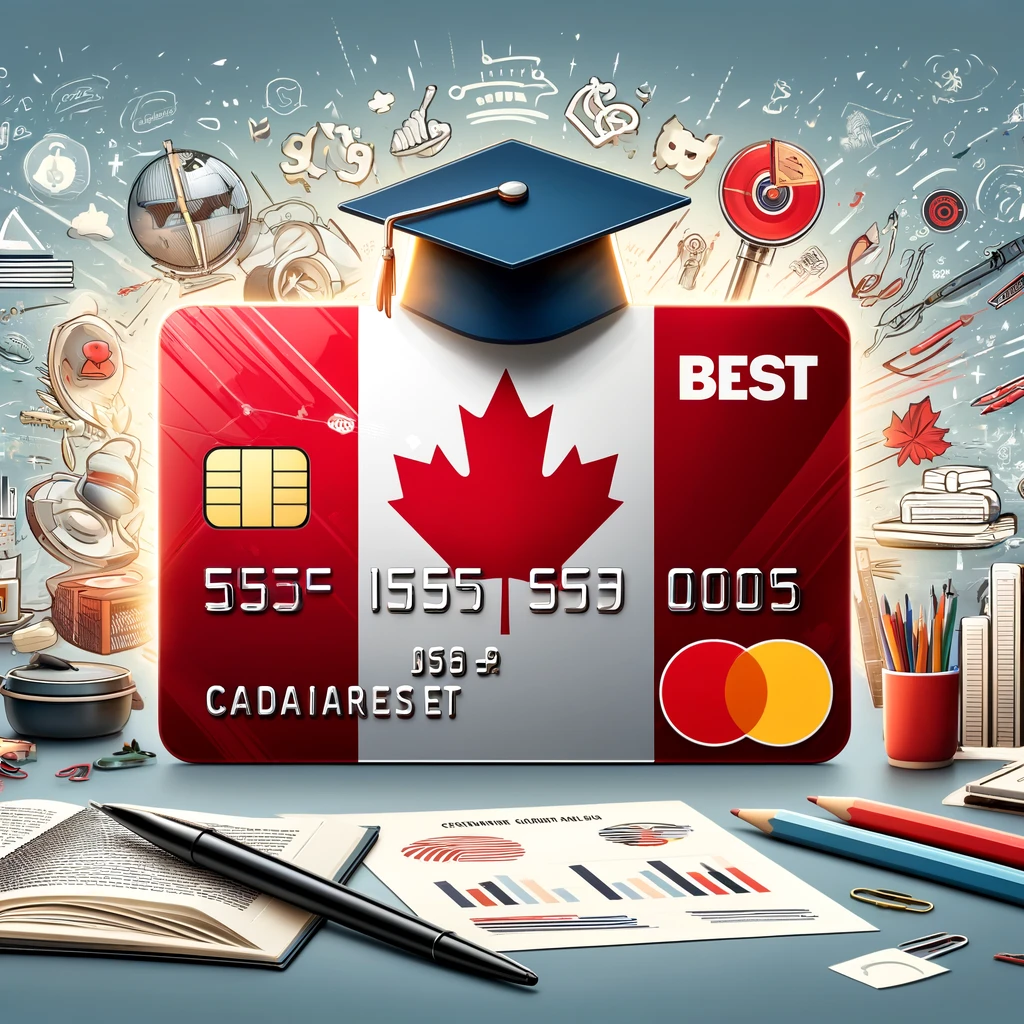The Best Credit Cards for Students in Canada - Compared
| Compare | Ratestead Rating | Annual Fee | Annual Rewards | Welcome Bonus | Learn More |
|---|
| APPLY NOW | /10 |
Student Credit Cards in Canada – What You Need to Know!
If you’re a Canadian student, you may have become aware of the special offers available for student credit cards. These credit cards are designed to provide students with an easy way to build their credit scores while getting access to the same benefits as any other credit card. But before you apply for one of these cards, it’s important to know what makes them different from other types of credit cards and how to use them responsibly.
Advantages of Student Credit Cards
The primary advantage of student credit cards is that they provide an opportunity for students to build their credit scores without taking on too much risk. Most student credit cards come with lower spending limits than regular credit cards, so even if you do incur debt on your card, it won’t be too difficult to pay it back. Additionally, many student credit cards also offer rewards programs or points systems that give you something back when you make purchases with your card.
Another great thing about student credit cards is that they usually come with zero-interest rates or very low interest rates. This means that interest payments are much lower than they would be if you used a regular credit card, which can help keep your debt levels down over time. Finally, some banks also offer additional perks such as free travel insurance and discounts at certain merchants when you use your student card.
Using Student Credit Cards Responsibly
Although there are many advantages to having a student credit card, it’s important to remember that they need to be used responsibly in order to get the most out of them. The key is not to overspend; stick within your budget and only make purchases when necessary. Additionally, always try to pay off any balances in full each month; this will help keep your debt levels down and prevent interest payments from piling up over time. Finally, make sure that you read all the terms and conditions associated with your card before signing up for one; this way, you’ll understand all the fees associated with using the card so there won’t be any surprises later on down the line.
Student credit cards can be a great way for Canadian students to start building their financial future while still enjoying many of the same benefits as regular adult consumers who have more established (and higher) spending limits attached to their accounts. Just remember that like any other type of financial product, student credit cards should be used responsibly in order to get the most out of them in terms of rewards points and low interest rates offered by banks and other providers across Canada today!
Tips for Applying for a Student Credit Card in Canada
Blog Introduction: As an international student studying in Canada, you may be considering applying for a student credit card, and rightfully so. Having access to a credit card can provide you with more financial flexibility while allowing you to build your credit score, which can help you when it comes time to apply for other forms of financing like a mortgage or car loan. But before you apply, there are some things that you should know first. Let’s take a look at the tips and tricks for applying for a student credit card in Canada.
Familiarize Yourself With Your Options
Before you apply for any type of financing product, it is important to do your research and understand exactly what type of product would best suit your needs. When it comes to student credit cards in Canada, there are multiple options available ranging from simple cashback rewards cards to more exclusive travel rewards cards with higher annual fees. It is important to familiarize yourself with each option so that you can make an informed decision about which one is right for you.
Check Your Credit Score
It is also important to check your credit score before applying for any form of financing as this will give you an idea of how much money lenders are willing to lend you and what kind of interest rate they will offer. In order to get the best deal on a student credit card in Canada, it is advisable that your score be at least 700 or higher. If your score is lower than this, it may be beneficial to wait until it increases before applying.
Apply Early
Finally, when applying for a student credit card in Canada, it is important that you do so early. This will give lenders ample time to review your application and make sure that all the necessary paperwork has been completed correctly before they approve or deny the request. Applying early will also give them enough time to contact you if additional information is needed or if there are any discrepancies on the application itself.
Applying for a student credit card in Canada can be an excellent way for international students to gain financial flexibility while building their credit score at the same time. Before filling out an application however, it is important that students familiarize themselves with their options and check their credit scores beforehand so they can get the best deal possible on their new card once approved by the lender. Additionally, applicants should try to submit their applications as early as possible so they have enough time to provide additional information if necessary before being approved or denied by the lender. Taking these steps can help ensure that international students get the most out of their new student credit cards in Canada!
How to apply for a Student Credit Card in Canada?
As a student in Canada, you may be wondering how to go about applying for a credit card. After all, having access to a credit card can be incredibly useful both during your studies and afterwards. It’s important to understand the process and make sure you get the best possible deal for your needs. That’s why we’ve put together this step-by-step guide on how to apply for a student credit card in Canada!
Step 1: Research Your Options
The first step is to research the different types of student credit cards available in Canada. Different banks offer different deals with varying interest rates and rewards programs, so it’s important to compare different offers and find one that works best for you. Make sure you’re also aware of any fees or charges associated with each card before making your decision.
Step 2: Gather the Required Documents
Once you’ve chosen which credit card you want to apply for, it’s time to start gathering the documents required by the bank. This will typically include proof of identity (such as a driver’s license) and proof of income (such as pay stubs). You will also need proof that you are currently enrolled in school, such as an acceptance letter or class schedule. Make sure all these documents are up-to-date and valid before submitting them with your application.
Step 3: Submit Your Application
Now that you have all the necessary documents ready, it’s time to submit your application! Most banks will have an online portal where you can fill out the form and upload any necessary documents quickly and easily. Alternatively, if you prefer dealing with people face-to-face, many Canadian banks also offer physical locations where you can submit your application in person.
Applying for a student credit card can be daunting but it doesn’t have to be—just follow our simple three-step guide! Do your research beforehand so that you understand what type of card is best suited for your needs; gather any necessary documents; then submit your application either online or at a physical location. With these steps completed, hopefully now you know how easy it is to apply for a student credit card in Canada! Good luck!
The Benefits of Getting a Student Credit Card in Canada
As a student, it’s important to take advantage of the many opportunities available to you. In Canada, one such opportunity is getting a student credit card. A student credit card can help build your credit score and give you access to rewards and other benefits. With that said, there are certain advantages and disadvantages that come with having a student credit card. Let’s explore what they are.
Benefits of Having a Student Credit Card
Student credit cards typically offer lower interest rates than regular cards, meaning that if you do find yourself carrying a balance from month-to-month, you will be able to pay off your debt faster. Additionally, student cards often offer rewards points for purchases made using the card. This is great because it means that even if you don’t have much disposable income at the moment, you can still save up rewards points for things like flights or hotel stays down the road. Finally, having a student credit card can be beneficial for building your credit score since payments are reported to the major Canadian credit bureaus each month.
Drawbacks of Having a Student Credit Card
Unfortunately, there are some drawbacks associated with having a student credit card as well. For example, most student cards have relatively low spending limits which means they may not be suitable for larger purchases such as furniture or electronics. Also, depending on the type of card you get and how you use it (or misuse it), there may be an annual fee assessed on your account which can add up over time. Finally, while having a student card may help build your credit score over time, if used irresponsibly it could also damage your score quickly – so it’s important to use caution when using this type of financial product!
All in all, getting a student credit card in Canada has its pros and cons just like any other type of financial product or service out there. While having access to lower interest rates and rewards points can certainly be attractive features for students looking to build their financial history or save money on large purchases down the road, it’s important to remember that misusing this type of product could potentially lead to long-term damage in terms of both money and reputation. So before taking out any form of consumer loan or debt product – including student cards – make sure you understand what comes with them and how best to manage them responsibly!
Disadvantages of a Student Credit Card in Canada
Student credit cards can be an excellent way for students to build their credit score and gain access to financial products that may not otherwise be available. But, like all forms of credit, student credit cards come with both advantages and disadvantages. Before signing up for a student credit card, it’s important to understand the potential drawbacks as well as the benefits.
High Interest Rates
One of the biggest disadvantages of student credit cards is that the interest rates tend to be higher than other types of cards. For example, many student credit cards have annual percentage rates (APRs) that exceed 20%. This means that if you carry a balance from month-to-month, your debt can quickly become unmanageable. That’s why it’s important to pay off your balance in full each month or else you could end up paying hundreds or even thousands of dollars in interest payments over time.
Lower Credit Limits
Another disadvantage is that many issuers limit student credit cardholders to lower spending limits than those given to regular customers. While this may seem like a good thing at first—after all, it helps keep your spending under control—it can also hurt your ability to build a good credit score by limiting the amount of money you can borrow each month. As such, it’s often best to apply for a regular rewards card if possible since they tend to offer higher limits and more rewards than student cards do.
Limited Reward Programs
Finally, one more disadvantage of student credit cards is that they typically don’t offer as many rewards programs as regular cards do. While some issuers may offer special discounts on certain products or services for their students (such as discounted movie tickets or hotel stays), these perks are usually limited when compared with what’s offered by standard reward programs. Additionally, most student reward programs tend to exclude travel rewards such as airline miles and hotel points – something that can be quite beneficial for students who are looking to save money on travel expenses while studying abroad or during summer break.
As you can see, there are both advantages and disadvantages associated with using a student credit card in Canada. Be sure to familiarize yourself with the terms and conditions before signing up so you know exactly what you’re getting into before committing yourself financially! All things considered though, if used correctly, having access to a student card can be very helpful in building your personal financial portfolio – just make sure you use it responsibly!
Student Credit Card FAQs
A student credit card is a type of credit card specifically designed for college or university students. These cards often have lower credit limits and may offer benefits tailored to students’ needs, such as rewards for common student expenses or tools to help build credit history.
Student credit cards work like regular credit cards, allowing cardholders to make purchases and borrow money up to their credit limit. Students are typically required to meet certain eligibility criteria, such as being enrolled in a post-secondary institution and having a minimum income or a co-signer.
Student credit cards offer benefits such as building credit history, providing financial flexibility for emergencies or unexpected expenses, and sometimes offering rewards or perks tailored to student spending habits.
Eligibility criteria vary by card issuer but typically include being a full-time or part-time student at a recognized post-secondary institution, being of legal age (18 or 19 depending on the province), and having a minimum income or a co-signer if you don’t meet the income requirements.
Many student credit cards do not have annual fees, although some may charge an annual fee with additional benefits or rewards. It’s essential to review the terms and conditions of the card to understand any fees associated with it.
Some credit card issuers in Canada may offer student credit cards to international students studying at Canadian universities or colleges. However, eligibility criteria, such as proof of enrollment and residency status, may vary, and international students may need to provide additional documentation.
Yes, using a student credit card responsibly by making on-time payments and keeping balances low can help build positive credit history, which is essential for future financial endeavors such as renting an apartment, getting a car loan, or applying for other types of credit.
Students should consider factors such as interest rates, fees, rewards or perks, credit limits, and the card issuer’s reputation for customer service and reliability. It’s essential to choose a card that aligns with your spending habits, financial goals, and ability to manage credit responsibly.
Some common mistakes include overspending beyond your means, missing payments or paying late fees, carrying a high balance and accruing interest charges, and neglecting to monitor your credit card statements for errors or fraudulent charges. It’s important to use credit cards responsibly to avoid financial pitfalls.




















